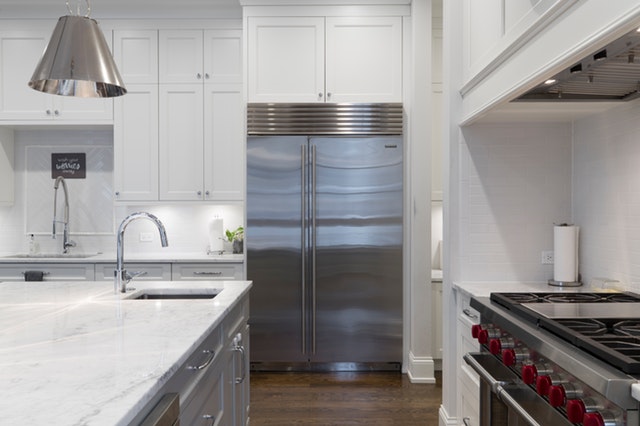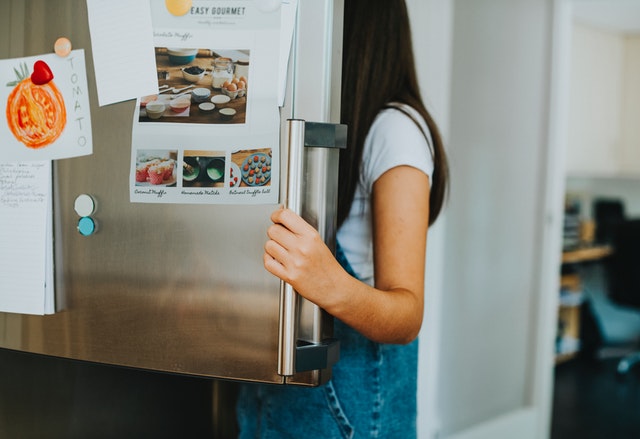Common Refrigerator Problems
There’s no doubt that refrigerators are one of the most important appliances every household can have; thanks to them, you can keep your groceries cool and in good shape for you and your family! Fridges are naturally a vital part of your house, so you need to keep an eye on yours to ensure it’s up and running. Daily use will eventually wear them out and, as it happens in life, age them too. Because of this, it’s helpful to know the most common refrigerator problems,

Common Refrigerator Problems
If you believe there may be something wrong with your fridge, then keep reading this article to determine what the problem is and if you can fix it yourself. As you will eventually see, DIY refrigerator repair methods do exist and work, and believe it or not, the best cases call for a simple unplugging and replugging procedure. Below are some common refrigerator problems and solutions.
Water Leaks from Underneath
Is your fridge leaking water from underneath it?. The source of this occurrence is not easy to find, as many things could cause a leak in your machine. However, the two most common ones are easy to locate and quick to fix, without the help of a technician.
The first cause could be a blocked defrost drain, which is the small duct at the back of the freezer, just above the slope from the floor at the back. You can fix this by just draining the hole with some warm water and/or using a long, stick-like instrument, such as a pipe cleaner, to remove the clog. If this doesn’t solve the problem, though, you’ll have to manually remove the clog with your own hands, but don’t worry, it’s not that hard to do. Simply pull your fridge away from the wall and locate the hose in the back of the service panel. Take it out, wash it with some hot water and soap and then reinstall it.
The second reason is similar, but this time it’s located in a different place. Sometimes the water supply can get clogged or even freeze, which causes the leaks and puddles on the floor. This is also the main cause behind your icemaker and water dispenser malfunctions. For this, it’s better to unplug the fridge and look for the shut-off valve, make sure it’s closed and then check the plastic supply line; if it is damaged, you might have to replace the water supply line.
The Freezer Isn’t Working Properly
Is your food spoiling faster than usual? Is your refrigerator not cooling at all? Before asking yourself about the quality and expiration dates of your products, ask yourself first if your freezer is running at all. If you discover it isn’t, then it’s time to apply a simple fix.
First, check if the back wall of the freezer is cold. If it is, then try to hear if the evaporator fan is running, or at least feel some cool air coming out of the freezer vents. If you can’t, then the problem lies on the fan, but if you do, and even hear the fan working, then check the fridge’s compressor and clean it from any dust it might contain and that could prevent the airflow through the coils nearby.
Your Machine Cycles Too Frequently
Noisy fridges are the worst. Not only are they a burden to your ears, but they’re also a burden on your pockets. The noise comes from the cycling process, which is a process that consumes too much electricity. There are some reasons behind the excessive amounts of cycles, but the most common ones are debris buildups and dusty condenser coils. Still, both require a similar fixing procedure, so don’t worry: the following fix will get in charge of both issues at the same time.
First, unplug your machine. Second, find the condenser coils and remove their “grill” by popping out the snaps that keep it in place. Now, use a small vacuum to drain the dust or debris around them; if there are other smaller pieces in places you can’t access, then recur to a small piece of cloth to get rid of those, carefully. Once you’re finished, put the grill back on its place and plug in the fridge.
If you discover that this isn’t the root of your problem, though, then check your fridge’s temperature. Low temperatures make refrigerators work overtime, so it’s better to keep it around 40 degrees Fahrenheit and to ensure it remains this way. However, if none of these solve the problem, then it’s better to call a repair technician and get sure if it mightn’t be a defective piece in your machine.

Why is my Refrigerator so Loud?
This could be connected to the compressor at the bottom of your machine. Remember that the condenser coils could get dusty, especially if the condenser fan nearby doesn’t air them enough, so perhaps the one to blame here is this fan.
Food Compartments Getting Warm
Aren’t your fresh food compartments cold enough to keep your groceries fresh? Believe it or not, but maybe the problem is not because of the compartment itself, but because of the freezer unit. The cold air inside refrigerators actually comes from the freezer unit. The freezers have an evaporator fan that moves the air to the main parts of your fridge through a diffuser, which is located at the fresh food section. So, if your compartments are warmer than usual, it’s likely because of an airflow issue related to any of these said elements.
First of all, listen if the evaporator fan is running, or check if there’s some air blowing from the freezer vents. If they’re working, and yet you have this issue, then maybe the problem lays on the diffuser.
What Would Cause a Refrigerator to Stop Getting Cold?
As we stated above, this problem tends to originate from the defrost system’s fan. Remember that all refrigerators count with a set of coils called “evaporators”, and if it frosts up, then something’s wrong with the fan and the coils.
There’s A Puddle of Ice at the Bottom of the Freezer
If you ever discover a thin frozen puddle at the bottom of your freezer, or even water drops leaking into your fridge, it might mean that your defrost drain valve is also blocked. Just like before, this isn’t a hard fix.
First things first: take out your food to a safer place for the time being and unplug the fridge. Afterwards, open all doors and let the ice melt. This would solve the issue on its simplest facet, but if you want to go through a more thorough fix, then remove the back wall of your freezer compartment before plugging your machine back in. Remove any other debris or food pieces that might be clogging the small hole at the base of the evaporator coils and plug in your fridge again. If this doesn’t solve the problem, then maybe you might need either a drain heater to help you with the defrost process, or professional help.
Overflowing Issues in the Ice Maker
This is quite a common problem, but the exact cause tends to be hard to pinpoint. Usually, the issue lies on the water pressure of the inlet valve. If it is too low, then it won’t close completely when you turn off the power, and in consequence, some water droplets may leak into the ice maker, causing it to overflow. You can solve this by simply ensuring that the water pressure is at least 20 psi, or that the valve itself is in good shape. If the water pressure is sufficient and yet there’s overflow, then consider getting a replacement for the water inlet valve.
Why Is My Fridge Freezing My Food?
Maybe you might have opened once your refrigerator and discovered some frosty areas among some of your products. If you are wondering why your fridge is freezing your food, don’t worry. While this isn’t the most common problem, it can be resolved. If your food is freezing in the non-freezer areas, then it’s likely an issue with the temperature control thermostat, which controls the power of both the compressor and evaporator fan. Basically, if this thermostat isn’t working properly, the fridge system will overwork and cause the unit to become colder than usual.
Can a Refrigerator be Overloaded?
Actually, yes. Overloading your refrigerator will hinder air circulation and make some spots colder than others. Watch out for the thermostat sensor, too. If you block it, the fan will run until it burns out, so careful with the way you store your food in the fridge. To check if your thermostat is working properly, try rotating it from the lowest setting to the highest one and wait for a loud click sound. If you hear it, then the good news: it’s in a good state. If you don’t, then test its continuity with a multimeter. If you discover that it doesn’t change, then you will have to replace the thermostat.
To Summarize
So, remember to keep an eye on any of the symptoms we just listed above and understand the problems before you try to fix them. It’s important to know when it’s best to repair or replace your refrigerator. In the best cases, you can apply these DIY maintenance tips for common refrigerator problems to help save some time. If none of these repairs work, however, then it’s better to call for a technician.
